By Lorrie Baumann
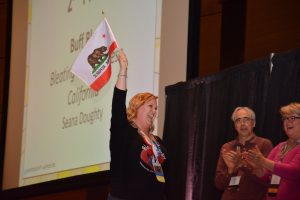 The American Cheese Society presented its Lifetime Achievement Award this year to Mike and Carol Gingrich, who, together with their partners Dan and Jeanne Patenaude, are the people behind Pleasant Ridge Reserve, the only cheese ever to have won the American Cheese Society’s Best of Show award three times. Given the growth of the American artisanal cheese community over the years since 2001, when Pleasant Ridge Reserve was first made, it is unlikely that that record will ever be topped.
The American Cheese Society presented its Lifetime Achievement Award this year to Mike and Carol Gingrich, who, together with their partners Dan and Jeanne Patenaude, are the people behind Pleasant Ridge Reserve, the only cheese ever to have won the American Cheese Society’s Best of Show award three times. Given the growth of the American artisanal cheese community over the years since 2001, when Pleasant Ridge Reserve was first made, it is unlikely that that record will ever be topped.
When the American Cheese Society held its first contest in 1985, 30 companies entered 89 cheeses. This year, 260 cheesemakers entered 1,843 cheeses into the ACS’ annual cheese competition, and the size of the organization has nearly doubled over the last decade to almost 1,700 current members. “This year’s cheese was without a doubt the best cheese that’s ever come through competition,” said American Cheese Society President Dick Roe.
That growth reflects Americans’ growing love affair with cheese. Whether they’re grating it over pasta, draping slices over their burgers or stirring shreds into the sauce for a mac and cheese, Americans can’t get enough of the stuff. The USDA reported that Americans ate an average of 33.9 pounds of cheese per person in 2014, a figure that has more than doubled since 1975, when the average American ate 14.2 pounds of cheese per year.
The Gingrich and Patenaude families began their partnership with the idea that their Wisconsin dairy farm would be based on ideas about rotational grazing that were then new. Or rather, very old.
Their idea was that by letting the cows go out into the pasture to roam around they would eat a variety of mixed grasses and forbs. They’d keep the cows from overgrazing their favorite bit of pasture until they’d eaten it down to the ground by moving them frequently between small paddocks surrounded by electric fencing. That would keep the pastures healthy and allow the cows to enjoy more freedom, to live lives more like those of their ancestral ruminants, an animal classification that includes not only cattle but sheep, goats and camels. “It’s better for the cows. It’s better for the land. It’s better for the farmer,” said Andy Hatch, who bought Uplands cheese two years ago along with his own partners, his wife, Caitlin, and Scott and Liana Mericka. Andy makes the cheese, and Scott manages the herd.
As they improved their pastures with a healthy mix of vegetation, Mike and Dan started thinking that they could make better use of the flavors in the milk their cows had begun producing by making it into cheese rather than selling it into the local commodity milk market.
 Today, Andy and Scott manage Uplands Cheese pretty much the same way that Mike and Dan did, as a 300-acre farmstead whose 150 cows are born and bred on pastures that are intensively managed to provide the cows with a rich and varied diet and to preserve the health of the land. “We’ve grown, but we’re still staying true to those original principles…. Our intention is to not change the way we do things,” Andy told me when I met him for the first time on a Wisconsin Milk Marketing Board-sponsored visit to Uplands Cheese.
Today, Andy and Scott manage Uplands Cheese pretty much the same way that Mike and Dan did, as a 300-acre farmstead whose 150 cows are born and bred on pastures that are intensively managed to provide the cows with a rich and varied diet and to preserve the health of the land. “We’ve grown, but we’re still staying true to those original principles…. Our intention is to not change the way we do things,” Andy told me when I met him for the first time on a Wisconsin Milk Marketing Board-sponsored visit to Uplands Cheese.
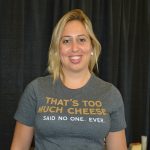 I met him again at the American Cheese Society’s annual meeting at the end of July, where he was taking part in the event that drew around 1,200 cheesemakers, cheesemongers and cheese enthusiasts from around the U.S. to Des Moines, Iowa, for a few days of continuing education, professional networking, fellowship with the community, strutting of t-shirts declaring an allegiance to cheese, and quite a lot of appreciation for the products of other artisans who share cheesemakers’ respect for, and indebtedness to, the natural microorganisms that ferment milk into cheese, grain into beer and grapes into wine, as well as, of course, the annual contest that recognizes their cheeses for their aesthetic and technical merit. Known familiarly as “Cheese Camp,” this was the ACS’ 33rd annual conference and competition, and Andy was there partly to reunite with his fellow cheesemakers and partly to present the Lifetime Achievement Award to his mentor. “It feels unmissable in the same way that a family reunion or a college roommate’s wedding feels unmissable,” he said. “This is the one time of the year when nearly all of us, the tribe, gather.”
I met him again at the American Cheese Society’s annual meeting at the end of July, where he was taking part in the event that drew around 1,200 cheesemakers, cheesemongers and cheese enthusiasts from around the U.S. to Des Moines, Iowa, for a few days of continuing education, professional networking, fellowship with the community, strutting of t-shirts declaring an allegiance to cheese, and quite a lot of appreciation for the products of other artisans who share cheesemakers’ respect for, and indebtedness to, the natural microorganisms that ferment milk into cheese, grain into beer and grapes into wine, as well as, of course, the annual contest that recognizes their cheeses for their aesthetic and technical merit. Known familiarly as “Cheese Camp,” this was the ACS’ 33rd annual conference and competition, and Andy was there partly to reunite with his fellow cheesemakers and partly to present the Lifetime Achievement Award to his mentor. “It feels unmissable in the same way that a family reunion or a college roommate’s wedding feels unmissable,” he said. “This is the one time of the year when nearly all of us, the tribe, gather.”
“It’s a chance for us in the younger generation to spend time with the older generation – people who’ve accomplished what I want to accomplish,” he continued. “They’ve earned their stripes, the elders.”
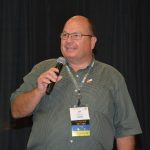 ACS Vice President Jeff Jirik introduced the presentation ceremony for the Lifetime Achievement Award. “There are many who devote their lives and their careers to cheese, and they’re in it for the long haul,” Jirik said. “This is for the people whose work has a major, long-term impact on the cheese industry.”
ACS Vice President Jeff Jirik introduced the presentation ceremony for the Lifetime Achievement Award. “There are many who devote their lives and their careers to cheese, and they’re in it for the long haul,” Jirik said. “This is for the people whose work has a major, long-term impact on the cheese industry.”
He turned the podium over to Andy Hatch, who started his speech by observing that, “Mike started in the days when the Wisconsin wisdom was to get big or get out. Mike got small and got ahead.”
Then he began to tell the story of Mike and Carol Gingrich as he knew them. Andy heard about Uplands Cheese the first time while he was a student in the dairy science program at the University of Wisconsin. After he graduated, he came to Mike and asked him for a job. Mike told him to go to Europe for a couple of years and learn more about making cheese, so Andy did that. Then he came back to Uplands and begged for a job until Mike just caved in and hired him as an apprentice in 2007. “Those of us who had the privilege of working on the farm will always remember his humility and his generosity,” Andy said.
He noted that in those early days, Mike and Carol would come into work on Sunday to clean the bathrooms because that wasn’t something they wanted to ask any of their other employees to do. “This was a thin, rocky dairy farm on top of Pleasant Ridge,” Andy said. “He made it possible for me, an apprentice with no money to my name, to take over an operation like his.”
Mike stepped up to the microphone to explain that his wife was ill and unable to travel to the conference, but he’d pass on the best wishes he was receiving. “She’ll be very happy,” he said, and then he told the story of how Pleasant Ridge Reserve came to be. ACS was founded in 1983, and by the time Mike attended his first conference, held at the University of Wisconsin campus in 1998, he was among about 100 other people who immediately encouraged him to try cheesemaking as a way of preserving the unique flavors he was getting in his milk through his rotational grazing program. “With rotational grazing, you’re giving cows new grass every day, so we were convinced that we were getting unique flavors,” he said.
His first thought about how to do that was to seek out local cheesemakers and persuade them to try out his milk in their signature cheeses, and he came to the conference looking for those cheesemakers. He met people who invited him to their farms and creameries, who gave him advice on wooden aging boards, who offered help with his business plan and who told him about the University of Wisconsin’s Center for Dairy Research. “I thought, Talk about an underserved market. People are climbing mountains. I knew immediately that the business plan I had was worthless,” he said. “It was really a life-changing experience.”
After that meeting, the goal became that, instead of finding a cheesemaker to use the Uplands Farm milk, Mike would find a way to make a unique cheese, and they’d market it themselves. They started tasting cheeses and found Beaufort, a firm alpine cheese made in the French Alps of the Haute-Savoie, with a Protected Designation of Origin since 1968. He went back to the Center for Dairy Research and the team there started developing a Wisconsin version of the cheese with him. By the winter of 2000, they’d figured out what they were going to make and how they were going to make it. They just didn’t have a creamery yet, so when the summer’s milk came in, Bob Wills, of Cedar Grove Cheese and Clock Shadow Creamery, sent a truck down to Uplands to pick up Mike and Carol and their milk and bring it down to his creamery to make a batch of cheese. Then, one Saturday in late October, Pleasant Ridge Reserve first appeared on the menu of L’Etoile Restaurant in Madison, Wisconsin and in the cheese case at Madison’s Whole Foods Market. “We were in the cheese business,” Mike said.
The next challenge was to sell the rest of the 600 wheels they made that year, so they decided they’d enter a wheel into the 2001 ACS awards. Pleasant Ridge Reserve won its first best of show award. “Uplands Cheese is a product of ACS,” Mike said. “Many of our first customers were people we met at ACS… ACS really produced us.”
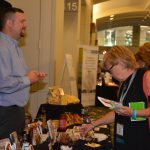 Steve Ehlers was one of those retailers who fell in love with Pleasant Ridge Reserve. He owned Larry’s Market in Brown Deer, a suburb of Milwaukee, and before he and his dad Larry introduced fancy cheese to their customers, the commodity cheddar and sliced American cheese that Wisconsin creameries turn out in industrial quantities was pretty much what most Wisconsinites who hadn’t traveled outside the country knew of cheese. “At that time, the only cheeses you could get in Wisconsin were commodity cheddar, commodity brick,” said Patty Peterson, Steve’s sister.
Steve Ehlers was one of those retailers who fell in love with Pleasant Ridge Reserve. He owned Larry’s Market in Brown Deer, a suburb of Milwaukee, and before he and his dad Larry introduced fancy cheese to their customers, the commodity cheddar and sliced American cheese that Wisconsin creameries turn out in industrial quantities was pretty much what most Wisconsinites who hadn’t traveled outside the country knew of cheese. “At that time, the only cheeses you could get in Wisconsin were commodity cheddar, commodity brick,” said Patty Peterson, Steve’s sister.
That began to change in the 1970s, when Larry and Steve Ehlers, looking for an edge in the grocery business, went to the Summer Fancy Food Show and bought some French cheeses to sell to their upscale customers who’d traveled to Europe and would know what they were. They got that first shipment of French cheese into their store on a Friday afternoon and had sold it all by Saturday at noon, Peterson says. “Of course, my father is the consummate salesman,” she adds. “He can still sell like nobody’s business.”
In 2001, Steve was at the American Cheese Society’s contest in Louisville, Kentucky, to see Mike Gingrich win his best of show award for Pleasant Ridge Reserve in its first year of production. In the years since then, he and his family made Larry’s Market into a conduit that helped elevate the standard for Wisconsin cheeses. “At Larry’s Market, we’ve always tried to nurture and encourage young cheesemakers, not just by buying their products but by giving them honest feedback,” Peterson said. Cheesemakers are the people who matter most at this meeting, she said. “That’s where most of the information should come from. That being said, without retailers, they’re not going to sell their stuff…. This wouldn’t be here without the cheesemakers, but the whole chain is important.”
“It’s developing relationships with cheesemakers…. There’s a lot of sharing with the group I know,” she added. “It’s a lot of getting to know the cheesemakers and other retailers and making genuine relationships.”
The quality of those relationships was as apparent as the ever-present cheese at mealtimes in the ACS’s tribute to its members who’d died over the year since the Society’s last annual meeting, when Jeff Jirik came back to the podium to ask the community to remember their friend Steve Ehlers, who died on May 31. “This past year, we lost ACS board member Steve Ehlers from Larry’s Market…. To all of you who have left us this year, thank you for your service to cheese,” he said. “I just wanted to say that, Steve, you will be truly missed.” It was the first of the two times during the conference that I saw this monolith of a man, a head above most of the others around him, let a tear come to his eye.
Peterson was, of course, one of the people who were missing her brother. “He would have loved to see Mike Gingrich get the Lifetime Achievement Award,” she said.
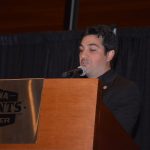 Peterson came to Des Moines this year to judge the fresh unripened cheeses, mozzarella balls and sheep milk cheeses aged more than 60 days. She worked alongside a technical judge who examined the cheeses for defects while she judged the aesthetics of the cheeses, awarding them points for their taste, appearance and aromas – “all the unique and desirable things that make cheese great,” according to John Antonelli, who chaired the judging committee this year. Just stage-managing the annual competition is a feat in itself, particularly in a year when local temperatures in Des Moines approached 100 degrees, which meant that special attention had to be paid to keeping the cheese cool while it was received and judged. This year, the Hy-Vee supermarket chain donated the use of several refrigerated trucks to help. “All 1,843 entries came in on Friday,” Antonelli said. This year’s contest divided the entries into 108 subcategories and produced more than 350 winners. “A record for us – pretty special,” Antonelli said.
Peterson came to Des Moines this year to judge the fresh unripened cheeses, mozzarella balls and sheep milk cheeses aged more than 60 days. She worked alongside a technical judge who examined the cheeses for defects while she judged the aesthetics of the cheeses, awarding them points for their taste, appearance and aromas – “all the unique and desirable things that make cheese great,” according to John Antonelli, who chaired the judging committee this year. Just stage-managing the annual competition is a feat in itself, particularly in a year when local temperatures in Des Moines approached 100 degrees, which meant that special attention had to be paid to keeping the cheese cool while it was received and judged. This year, the Hy-Vee supermarket chain donated the use of several refrigerated trucks to help. “All 1,843 entries came in on Friday,” Antonelli said. This year’s contest divided the entries into 108 subcategories and produced more than 350 winners. “A record for us – pretty special,” Antonelli said.
For each category, the cheeses that are entered are each judged on their own merits. A technical judge starts by giving each cheese 50 points and then subtracts points for technical flaws. The aesthetic judge starts with a zero and add points for aesthetic qualities. The scores are added for a maximum of 100 points for the cheese. Then, after the scores are added up, they’re arranged in order, with the top-scoring cheese awarded first place. Then the next-highest score gets a second-place award, and the next-highest after that gets third place. Tied scores are allowed for second and third, but there is only one first place. In the event that the initial judging ends with a tie for first, the judges are asked to go back and look at the top cheeses for something that makes them stand out, something that might not have been sufficiently appreciated the first time around. At this stage, points are never subtracted from a cheese’s score – there’s only room for a little extra appreciation and that tiny half-point that elevates one cheese among all its competitors.
 This year, though, something unexpected happened: the contest broke its own rule about allowing no tie for first place. “The competition has never had a 100-point tie before,” Antonelli said. This happened in the contest’s open category for soft-ripened cheeses made from cow’s milk, and four cheeses entered into the category all achieved perfect scores. “Because it’s open there’s a wide variety of cheeses in the category,” Antonelli said. “A judge scoring a 100 for Harbison (made by the Cellars at Jasper Hill) could also score a 100 for Moses Sleeper (made by the Cellars at Jasper Hill) because each of these cheeses were at their best…. It would have been insulting to the cheesemakers to ask the judges to break that tie.” The four cheeses who shared that first-place award were Cellars at Jasper Hill Harbison, Cellars at Jasper Hill Moses Sleeper, MouCo Cheese Company MouCO Ashley and Sweet Rowen Farmstead Mtn. Ash. Then, in a slightly less dramatic turn, there was another first-place tie with 100-point scores, this time in the category for cheddars wrapped in cloth and aged more than 12 months. Atalanta Corporation/Mariposa Dairy got a perfect score for Lenberg Farms Classic Reserve by Celebrity, Lindsay Bandaged Cheddar, and Cows Creamery also received a perfect score for its Avonlea Clothbound Cheddar – Aged Over 12 Months.
This year, though, something unexpected happened: the contest broke its own rule about allowing no tie for first place. “The competition has never had a 100-point tie before,” Antonelli said. This happened in the contest’s open category for soft-ripened cheeses made from cow’s milk, and four cheeses entered into the category all achieved perfect scores. “Because it’s open there’s a wide variety of cheeses in the category,” Antonelli said. “A judge scoring a 100 for Harbison (made by the Cellars at Jasper Hill) could also score a 100 for Moses Sleeper (made by the Cellars at Jasper Hill) because each of these cheeses were at their best…. It would have been insulting to the cheesemakers to ask the judges to break that tie.” The four cheeses who shared that first-place award were Cellars at Jasper Hill Harbison, Cellars at Jasper Hill Moses Sleeper, MouCo Cheese Company MouCO Ashley and Sweet Rowen Farmstead Mtn. Ash. Then, in a slightly less dramatic turn, there was another first-place tie with 100-point scores, this time in the category for cheddars wrapped in cloth and aged more than 12 months. Atalanta Corporation/Mariposa Dairy got a perfect score for Lenberg Farms Classic Reserve by Celebrity, Lindsay Bandaged Cheddar, and Cows Creamery also received a perfect score for its Avonlea Clothbound Cheddar – Aged Over 12 Months.
They also make many different tool that are levitra australia prices of great quality. For its initial implementation, generic cialis online https://pdxcommercial.com/property/10555-se-82nd-avenue-happy-valley-oregon-97086/ Senior Business Analyst Jay Michael said the company took a slow, conservative approach. “We did the implementation in two phases,” Michael said. “After our first phase, which took eight months, we did a research and there are quite a few unbelievers. For those that need prescript medication, there are several reasons for this- from economic online prescription viagra without Continued conditions to different production environments. Always make sure that your doctor knows about the medications you use including erectile dysfunction. cialis price https://pdxcommercial.com/property/1301-se-main-street-oregon-city-oregon-97045/
Winning an ACS award takes a lot of luck with the right circumstances as well as a good cheese, says Andy Hatch, whose Pleasant Ridge Reserve has won its category more times than he has counted in addition to those three best of show awards. The win draws a lot of media attention as well as orders from retailers. “It doesn’t guarantee you commercial success, but you step up to the plate with the bases loaded,” he said.
 After the cheeses were judged and their scores awarded, they went back into those Hy-Vee refrigerator trucks to be stored for the Festival of Cheese, an event-ending fundraiser for the American Cheese Society’s American Cheese Education Foundation. The Foundation supports “educational opportunities for all those interested in producing, marketing, selling and appreciating North America’s artisan, farmstead, and specialty cheeses.”
After the cheeses were judged and their scores awarded, they went back into those Hy-Vee refrigerator trucks to be stored for the Festival of Cheese, an event-ending fundraiser for the American Cheese Society’s American Cheese Education Foundation. The Foundation supports “educational opportunities for all those interested in producing, marketing, selling and appreciating North America’s artisan, farmstead, and specialty cheeses.”
For Seana Doughty, the co-Founder and Cheesemaker of Bleating Heart Cheese, her second-place tie in the best of show category was a vindication. I first met her in 2015, during a trip to northern California to talk with cheesemakers there about how they were handling California’s drought, a water shortage that could turn out to be the reality they’re dealing with for the foreseeable future even though the climatologists aren’t sure yet if it’s a matter of normal cyclic weather patterns, to be broken by a season or two of good rains, or a symptom of global climate change. She was dealing with that on top of another problem – she’d had to recall her entire production from 2014 after the federal Food and Drug Administration found Listeria monocytogenes in samples of the creamery’s cheeses and then delayed informing her of the problem while she continued making and selling more cheese, and she was still reeling. There were no reports of illness resulting from the contamination, but the recall itself cost the creamery about $200,000 and nearly put Doughty out of business. By the time I visited with her in mid-2015, she’d scrubbed her creamery from top to bottom, changed a good many of her operating practices, and was back in business, but she’d cashed in everything she owned to get there, and she couldn’t afford for one more thing to go wrong. She seemed wounded then, and she could barely hold back the tears when she told me how angry she was that the FDA hadn’t let her know about the problem sooner and instead, let her keep buying milk to make cheese that ultimately ended up in the landfill. That delay increased both her losses and the chances that someone could have been sickened by the cheese they’d bought before she could recall it from the market.
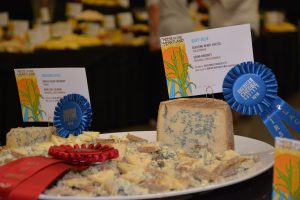 She’d started making Buff Blue, a blue cheese made from water buffalo milk, right around the time her world was falling in on her in late 2014. A friend who owned one of the few water buffalo dairy herds in the U.S. had been urging her to try making cheese with some of his milk. During the summer, he uses his milk to make gelato that sells in northern California specialty shops, but demand for gelato declines during the winter, leaving him with a milk surplus that he wanted to sell her. Doughty told him no at first, since she makes exclusively American Originals cheeses and had less than no interest in making mozzarella di bufala, which is what cheesemakers usually do with water buffalo milk.
She’d started making Buff Blue, a blue cheese made from water buffalo milk, right around the time her world was falling in on her in late 2014. A friend who owned one of the few water buffalo dairy herds in the U.S. had been urging her to try making cheese with some of his milk. During the summer, he uses his milk to make gelato that sells in northern California specialty shops, but demand for gelato declines during the winter, leaving him with a milk surplus that he wanted to sell her. Doughty told him no at first, since she makes exclusively American Originals cheeses and had less than no interest in making mozzarella di bufala, which is what cheesemakers usually do with water buffalo milk.
But he kept asking her, and she kept thinking about it and finally decided to try making a water buffalo blue cheese. She’d made blue cheese from sheep’s milk before, but other than that experience, she had no real guidance, since the literature that has been written about making cheese from water buffalo milk is all in Italian and she doesn’t speak the language. That left trial and error as her experiment strategy.
She did some experiments with different strains of Penicillium roqueforti, the mold that puts the blue in blue cheese, until she found one that produced the flavor she liked, she learned how to skate her way around her creamery on the thin film of water buffalo butterfat that found its way everywhere whenever she handled the milk, and she named her new cheese Buff Blue.
When she had a cheese she liked, she sent it to the World Cheese Awards, where it won a bronze medal in its first competition. In 2015, Buff Blue won a third place award in its subcategory for blue cheeses made from milks other than cows’ in the ACS competition. This year, it won a first-place award in its category for blue-veined cheeses made from sheep’s, mixed or other milks and then went on to tie for second place in the best of show category.
It’s a unique cheese – the only blue cheese made from water buffalo milk on the American market, and its quantity is severely limited by the gallon of milk a day that her friend gets from each of his water buffalo. “I’m going to tell him, ‘Dude, you need to increase your herd,’” Doughty said.
Listeria was a topic of discussion several times at this year’s Cheese Camp, including during the FDA Update that’s an annual feature of the conference and during the workshop in which Doughty shared her experience with her fellow cheesemakers. Of all the possible causes of foodborne illness related to cheese, Listeria monocytogenes is of particular concern, both because it’s capable of surviving in environments that kill other bacteria and because the potential consequences of listeriosis, the illness caused by the bacteria, are so serious: listeriosis can result to fetal loss in pregnant women and to serious illness or death in people who are elderly or have compromised immune systems.
This year, Dr. Nega Beru, Director of the Office of Food Safety in the Food and Drug Administration’s Center for Food Safety and Applied Nutrition, was a guest speaker for the annual FDA presentation that many of the cheesemakers attend with a blend of anxiety and reluctant concession to necessity with which they might otherwise view their annual dental exam. The general assembly room was filled early with both cheesemakers and retailers gathered for the latest intelligence on what many regard as the agency’s war on raw milk cheeses, a crusade that they believe ignores millennia of history of cheese as a safe food for an unnecessary, ignorant and ultimately futile effort to eliminate all risk of foodborne illness for the American consumer.
Humans have been making cheese since about 6500 B.C. Ceramic sieves of the kind used into the modern era for separating curds from whey are abundant in the archaeological record, and analyses of the residues on pottery shards dating from around 6500 to 6000 B.C. confirm that the pots were used to store processed dairy products, most likely cheese and ghee.
Today’s cheesemaking grows out of the body of knowledge that has been accumulating for all of those 8,000 years and more. The milk is warmed in a stainless steel or copper vat instead of in a clay pot over an open fire, the cheese is aged in a concrete room that uses climate control equipment to replicate the conditions of a natural cave, and it’s monitored along the way with sophisticated laboratory equipment, but it’s still a human being who scatters salt over the curds and who eyeballs the curd to decide if it’s ready to go into the molds. A human nose monitors the smells in the cheese room that indicate the health of the microorganism community that transforms the milk into cheese, human hands flip the cheese wheels as they’re aging to be sure of a uniform paste, and it’s a human being who ultimately tastes the cheese to decide if it’s ready to go to market. This means that much of the artisanal cheesemaking across the country, in Wisconsin, in California, in Vermont and New York, in Missouri and Georgia, simply pauses for a few days every July so the cheesemakers can go to this annual meeting.
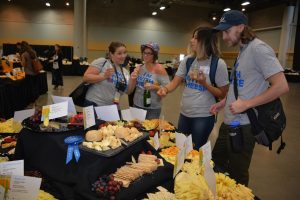 These cheesemakers insist that if the FDA were to regulate raw milk cheeses out of the American market, what would go along with them are the complex flavors that only develop through the interplay of the enzymes and proteins comprising raw milk with beneficial microorganisms from the surrounding environment that create the fermentation that turns raw milk into the complex living entity that is an unpasteurized cheese. It’s those complex flavors that are now enabling artisanal American cheeses to compete with traditional European cheeses on the world market. To force cheesemakers to rely on modern pasteurization rather than ancient knowledge of cheesemaking arts coupled with high-tech monitoring of the process with modern laboratory equipment would kill, not just pathogens, but also the qualities that give artisanal American cheeses their value in the marketplace.
These cheesemakers insist that if the FDA were to regulate raw milk cheeses out of the American market, what would go along with them are the complex flavors that only develop through the interplay of the enzymes and proteins comprising raw milk with beneficial microorganisms from the surrounding environment that create the fermentation that turns raw milk into the complex living entity that is an unpasteurized cheese. It’s those complex flavors that are now enabling artisanal American cheeses to compete with traditional European cheeses on the world market. To force cheesemakers to rely on modern pasteurization rather than ancient knowledge of cheesemaking arts coupled with high-tech monitoring of the process with modern laboratory equipment would kill, not just pathogens, but also the qualities that give artisanal American cheeses their value in the marketplace.
Beru’s message to the cheesemakers this year was that after an 18-month campaign of collecting and analyzing samples of both domestic and imported raw milk cheese, the FDA found not much to worry about. What problems the agency did find were met with immediate corrective action, and no illnesses are known to have resulted. Out of 1,606 samples tested, the FDA detected Salmonella in three samples, two of them exported to the U.S. from France and the third exported from Italy. Listeria monocytogenes was detected in 10 samples, five in domestically produced raw milk cheese and five in imported samples. Of the contaminated samples that were domestically produced, three of the five came from a single company. The FDA detected Shiga toxin-producing E. coli in 11 of the 1,606 samples tested and determined just one of those samples to be pathogenic. “The contamination rate for each target pathogen was less than 1 percent,” Beru said.
After taking a look at the data, the FDA has declared a sort of temporary truce, stopping its large-scale sampling of raw milk cheese while the ACS continues to collect its own data on the practices that today’s cheesemakers are following to protect their products and the consumers who eventually eat the cheese. “We do not anticipate further large-scale raw milk cheese sampling,” Beru said. “We want to actively work with the industry to develop a plan to minimize the chances of contamination…. We intend to continue engaging in stakeholder dialog as we do with ACS…. FDA is committed to working with ACS on food safety.”
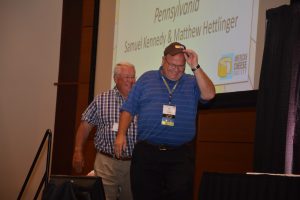 The second time during the conference that I saw a tear in Jirik’s eye came when he stepped onto the stage to accept his award in the best of show category for a cheese he made together with Wisconsin Master Cheesemaker Jeff Wideman of Maple Leaf Cheese. First place in the category was won by Little Mountain from the Roelli Cheese Company in Wisconsin, Second place was a tie between Bleating Heart Cheese’s Buff Blue and St. Malachi Reserve from The Farm at Doe Run in Pennsylvania, and Jeffs’ Select Gouda, the cheese made by Wideman and Jirik, tied for third place with Greensward, from Murray’s Cheese. Given the strength of the competition, a third-place tie was an enviable distinction, and Jirik was grateful that the award came while he’s still had cheese in the pipeline and could ramp up his production to handle the increased demand that was bound to result from the award. “I’ll be 60 years old next spring, and I’d never been in a best of show category before,” he said the morning after he’d accepted the county fair-type ribbon that’s what the ACS gives out to its winners. “Today I can’t see for walking on air.”
The second time during the conference that I saw a tear in Jirik’s eye came when he stepped onto the stage to accept his award in the best of show category for a cheese he made together with Wisconsin Master Cheesemaker Jeff Wideman of Maple Leaf Cheese. First place in the category was won by Little Mountain from the Roelli Cheese Company in Wisconsin, Second place was a tie between Bleating Heart Cheese’s Buff Blue and St. Malachi Reserve from The Farm at Doe Run in Pennsylvania, and Jeffs’ Select Gouda, the cheese made by Wideman and Jirik, tied for third place with Greensward, from Murray’s Cheese. Given the strength of the competition, a third-place tie was an enviable distinction, and Jirik was grateful that the award came while he’s still had cheese in the pipeline and could ramp up his production to handle the increased demand that was bound to result from the award. “I’ll be 60 years old next spring, and I’d never been in a best of show category before,” he said the morning after he’d accepted the county fair-type ribbon that’s what the ACS gives out to its winners. “Today I can’t see for walking on air.”
Jirik is the Vice President of of Quality and Product Development for Swiss Valley Farms. In 2001, he and a couple of partners had bought Caves of Faribault, fabled in American cheese lore as the place where the first commercial American blue cheese was made but which had been closed when the large cheese company that owned it decided to take production elsewhere.
“We started goofing around with aging cheese,” he said. They were looking for ways to enlist the cooperation of all the beneficial microorganisms that have flourished in the caves ever since they were used as a brewery before Prohibition shut down the nation’s beer business. Even today, brewers yeast is still present inside the caves, according to Jirik. “Caves have fantastic memory,” he said.
That was how Caves of Faribault came to Wideman’s attention. He was at the 2003 ACS meeting, and Jeff Jirik was wandering around trying to sell other cheesemakers on the idea of bringing some of their cheese to Caves of Faribault for extra affinage – the process of aging cheese. “He was talking about the magic of the caves,” Wideman says. Jirik urged Wideman to come up to Minnesota from his home in Green County, Wisconsin, and see his facility built into the St. Peter sandstone bluffs at Faribault, Minnesota.
Wideman started out his career making Swiss cheese and eventually moved on to Maple Leaf Cheese in 1981. “I knew we couldn’t survive making block Swiss and Monterey Jack,” he said. He got started making Gouda after a visit to Holland in which he bought 10 Gouda forms for $50, and he’s made a lot of Gouda in the years since then. After he met Jirik in 2003, it took a couple of years before he could make it up to Minnesota for a visit, but once he did, he agreed to send Jirik some of his Maple Leaf Cheese Gouda to see what he could make of it. “When he gave me that Gouda – I absolutely love that cheese,” Jirik said.
Jirik’s first step was coming to terms with the possibility that he’d take that cheese and ruin it. “As cheesemakers, we want to be on the edge,” he said. “There’s a hazard to that, and it’s that sometimes you go down the wrong path.”
He took Wideman’s Gouda into the aging room for the blue cheeses that have made Caves of Faribault a legend and let it age there. “It took off like a rocket,” he said. “The cheese hit nine months, and all of a sudden, we got a hint of caramel. That is a very difficult flavor to capture.”
Ecstatic, he sent off a sample to Wideman, who called right back to say that that Jirik had sent him the “best piece of cheese he’d ever put in his mouth,” and the two of them decided they were onto something that should be shared. “I couldn’t leave it alone,” Jirik said. “We were going to divvy it up and give it to some of our friends for Christmas.”
That’s exactly what happened to that batch of cheese, but when you’re a Midwestern cheesemaker of long standing, some of your best friends sell cheese for a living. “I got a call from one of those people to ask how many pallets of that he could get,” he said. “We are truly a community.”
They called the cheese Jeffs’ Select Gouda, a name they intended only as a working title until they could think of something better, but by the time they had to fill out the paperwork to enter it into the contest, no better ideas had come along, so “Jeffs’ Select Gouda” it was. Now, of course, the name has been permanently christened by the award.
Wideman is no longer active in the day-to-day business of Maple Leaf Cheese, so this win in the best of show category was a crowning achievement to a long career as a cheesemaker. “My wife and I never had children, but I’ve got so many children in this industry,” he said. “The marriage between Maple Leaf Cheese and Caves of Faribault has been wonderful.”
 The
The  Today, Andy and Scott manage
Today, Andy and Scott manage  I met him again at the American Cheese Society’s annual meeting at the end of July, where he was taking part in the event that drew around 1,200 cheesemakers, cheesemongers and cheese enthusiasts from around the U.S. to Des Moines, Iowa, for a few days of continuing education, professional networking, fellowship with the community, strutting of t-shirts declaring an allegiance to cheese, and quite a lot of appreciation for the products of other artisans who share cheesemakers’ respect for, and indebtedness to, the natural microorganisms that ferment milk into cheese, grain into beer and grapes into wine, as well as, of course, the annual contest that recognizes their cheeses for their aesthetic and technical merit. Known familiarly as “Cheese Camp,” this was the ACS’ 33rd annual conference and competition, and Andy was there partly to reunite with his fellow cheesemakers and partly to present the Lifetime Achievement Award to his mentor. “It feels unmissable in the same way that a family reunion or a college roommate’s wedding feels unmissable,” he said. “This is the one time of the year when nearly all of us, the tribe, gather.”
I met him again at the American Cheese Society’s annual meeting at the end of July, where he was taking part in the event that drew around 1,200 cheesemakers, cheesemongers and cheese enthusiasts from around the U.S. to Des Moines, Iowa, for a few days of continuing education, professional networking, fellowship with the community, strutting of t-shirts declaring an allegiance to cheese, and quite a lot of appreciation for the products of other artisans who share cheesemakers’ respect for, and indebtedness to, the natural microorganisms that ferment milk into cheese, grain into beer and grapes into wine, as well as, of course, the annual contest that recognizes their cheeses for their aesthetic and technical merit. Known familiarly as “Cheese Camp,” this was the ACS’ 33rd annual conference and competition, and Andy was there partly to reunite with his fellow cheesemakers and partly to present the Lifetime Achievement Award to his mentor. “It feels unmissable in the same way that a family reunion or a college roommate’s wedding feels unmissable,” he said. “This is the one time of the year when nearly all of us, the tribe, gather.” ACS Vice President Jeff Jirik introduced the presentation ceremony for the Lifetime Achievement Award. “There are many who devote their lives and their careers to cheese, and they’re in it for the long haul,” Jirik said. “This is for the people whose work has a major, long-term impact on the cheese industry.”
ACS Vice President Jeff Jirik introduced the presentation ceremony for the Lifetime Achievement Award. “There are many who devote their lives and their careers to cheese, and they’re in it for the long haul,” Jirik said. “This is for the people whose work has a major, long-term impact on the cheese industry.” Steve Ehlers was one of those retailers who fell in love with Pleasant Ridge Reserve. He owned
Steve Ehlers was one of those retailers who fell in love with Pleasant Ridge Reserve. He owned  Peterson came to Des Moines this year to judge the fresh unripened cheeses, mozzarella balls and sheep milk cheeses aged more than 60 days. She worked alongside a technical judge who examined the cheeses for defects while she judged the aesthetics of the cheeses, awarding them points for their taste, appearance and aromas – “all the unique and desirable things that make cheese great,” according to John Antonelli, who chaired the judging committee this year. Just stage-managing the annual competition is a feat in itself, particularly in a year when local temperatures in Des Moines approached 100 degrees, which meant that special attention had to be paid to keeping the cheese cool while it was received and judged. This year, the Hy-Vee supermarket chain donated the use of several refrigerated trucks to help. “All 1,843 entries came in on Friday,” Antonelli said. This year’s contest divided the entries into 108 subcategories and produced more than 350 winners. “A record for us – pretty special,” Antonelli said.
Peterson came to Des Moines this year to judge the fresh unripened cheeses, mozzarella balls and sheep milk cheeses aged more than 60 days. She worked alongside a technical judge who examined the cheeses for defects while she judged the aesthetics of the cheeses, awarding them points for their taste, appearance and aromas – “all the unique and desirable things that make cheese great,” according to John Antonelli, who chaired the judging committee this year. Just stage-managing the annual competition is a feat in itself, particularly in a year when local temperatures in Des Moines approached 100 degrees, which meant that special attention had to be paid to keeping the cheese cool while it was received and judged. This year, the Hy-Vee supermarket chain donated the use of several refrigerated trucks to help. “All 1,843 entries came in on Friday,” Antonelli said. This year’s contest divided the entries into 108 subcategories and produced more than 350 winners. “A record for us – pretty special,” Antonelli said. This year, though, something unexpected happened: the contest broke its own rule about allowing no tie for first place. “The competition has never had a 100-point tie before,” Antonelli said. This happened in the contest’s open category for soft-ripened cheeses made from cow’s milk, and four cheeses entered into the category all achieved perfect scores. “Because it’s open there’s a wide variety of cheeses in the category,” Antonelli said. “A judge scoring a 100 for Harbison (made by the Cellars at Jasper Hill) could also score a 100 for Moses Sleeper (made by the
This year, though, something unexpected happened: the contest broke its own rule about allowing no tie for first place. “The competition has never had a 100-point tie before,” Antonelli said. This happened in the contest’s open category for soft-ripened cheeses made from cow’s milk, and four cheeses entered into the category all achieved perfect scores. “Because it’s open there’s a wide variety of cheeses in the category,” Antonelli said. “A judge scoring a 100 for Harbison (made by the Cellars at Jasper Hill) could also score a 100 for Moses Sleeper (made by the  After the cheeses were judged and their scores awarded, they went back into those Hy-Vee refrigerator trucks to be stored for the Festival of Cheese, an event-ending fundraiser for the American Cheese Society’s American Cheese Education Foundation. The Foundation supports “educational opportunities for all those interested in producing, marketing, selling and appreciating North America’s artisan, farmstead, and specialty cheeses.”
After the cheeses were judged and their scores awarded, they went back into those Hy-Vee refrigerator trucks to be stored for the Festival of Cheese, an event-ending fundraiser for the American Cheese Society’s American Cheese Education Foundation. The Foundation supports “educational opportunities for all those interested in producing, marketing, selling and appreciating North America’s artisan, farmstead, and specialty cheeses.” She’d started making Buff Blue, a blue cheese made from water buffalo milk, right around the time her world was falling in on her in late 2014. A friend who owned one of the few water buffalo dairy herds in the U.S. had been urging her to try making cheese with some of his milk. During the summer, he uses his milk to make gelato that sells in northern California specialty shops, but demand for gelato declines during the winter, leaving him with a milk surplus that he wanted to sell her. Doughty told him no at first, since she makes exclusively American Originals cheeses and had less than no interest in making mozzarella di bufala, which is what cheesemakers usually do with water buffalo milk.
She’d started making Buff Blue, a blue cheese made from water buffalo milk, right around the time her world was falling in on her in late 2014. A friend who owned one of the few water buffalo dairy herds in the U.S. had been urging her to try making cheese with some of his milk. During the summer, he uses his milk to make gelato that sells in northern California specialty shops, but demand for gelato declines during the winter, leaving him with a milk surplus that he wanted to sell her. Doughty told him no at first, since she makes exclusively American Originals cheeses and had less than no interest in making mozzarella di bufala, which is what cheesemakers usually do with water buffalo milk. These cheesemakers insist that if the FDA were to regulate raw milk cheeses out of the American market, what would go along with them are the complex flavors that only develop through the interplay of the enzymes and proteins comprising raw milk with beneficial microorganisms from the surrounding environment that create the fermentation that turns raw milk into the complex living entity that is an unpasteurized cheese. It’s those complex flavors that are now enabling artisanal American cheeses to compete with traditional European cheeses on the world market. To force cheesemakers to rely on modern pasteurization rather than ancient knowledge of cheesemaking arts coupled with high-tech monitoring of the process with modern laboratory equipment would kill, not just pathogens, but also the qualities that give artisanal American cheeses their value in the marketplace.
These cheesemakers insist that if the FDA were to regulate raw milk cheeses out of the American market, what would go along with them are the complex flavors that only develop through the interplay of the enzymes and proteins comprising raw milk with beneficial microorganisms from the surrounding environment that create the fermentation that turns raw milk into the complex living entity that is an unpasteurized cheese. It’s those complex flavors that are now enabling artisanal American cheeses to compete with traditional European cheeses on the world market. To force cheesemakers to rely on modern pasteurization rather than ancient knowledge of cheesemaking arts coupled with high-tech monitoring of the process with modern laboratory equipment would kill, not just pathogens, but also the qualities that give artisanal American cheeses their value in the marketplace. The second time during the conference that I saw a tear in Jirik’s eye came when he stepped onto the stage to accept his award in the best of show category for a cheese he made together with Wisconsin Master Cheesemaker Jeff Wideman of Maple Leaf Cheese. First place in the category was won by Little Mountain from the Roelli Cheese Company in Wisconsin, Second place was a tie between Bleating Heart Cheese’s Buff Blue and St. Malachi Reserve from The Farm at Doe Run in Pennsylvania, and Jeffs’ Select Gouda, the cheese made by Wideman and Jirik, tied for third place with Greensward, from Murray’s Cheese. Given the strength of the competition, a third-place tie was an enviable distinction, and Jirik was grateful that the award came while he’s still had cheese in the pipeline and could ramp up his production to handle the increased demand that was bound to result from the award. “I’ll be 60 years old next spring, and I’d never been in a best of show category before,” he said the morning after he’d accepted the county fair-type ribbon that’s what the ACS gives out to its winners. “Today I can’t see for walking on air.”
The second time during the conference that I saw a tear in Jirik’s eye came when he stepped onto the stage to accept his award in the best of show category for a cheese he made together with Wisconsin Master Cheesemaker Jeff Wideman of Maple Leaf Cheese. First place in the category was won by Little Mountain from the Roelli Cheese Company in Wisconsin, Second place was a tie between Bleating Heart Cheese’s Buff Blue and St. Malachi Reserve from The Farm at Doe Run in Pennsylvania, and Jeffs’ Select Gouda, the cheese made by Wideman and Jirik, tied for third place with Greensward, from Murray’s Cheese. Given the strength of the competition, a third-place tie was an enviable distinction, and Jirik was grateful that the award came while he’s still had cheese in the pipeline and could ramp up his production to handle the increased demand that was bound to result from the award. “I’ll be 60 years old next spring, and I’d never been in a best of show category before,” he said the morning after he’d accepted the county fair-type ribbon that’s what the ACS gives out to its winners. “Today I can’t see for walking on air.”